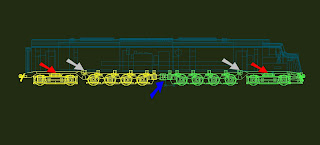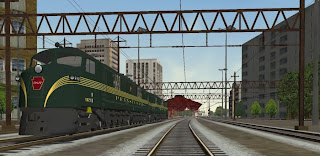I'm hedging a bet here because I still don't have the Shapeways sample for the overall shape, but folks seem interested. I thought I might describe what I'm hoping to do. Talking it out will help the idea crystallize in my head.
To start, let me show you the original digital model. It has many of the same characteristics of the "real" (analog?) model. The relationship between the various parts of the drive and shell are much the same...
 |
| Original Digital PRR Class BP60 #5827 |
In the image above you are looking at the wireframe of one of the PRR centipedes I made. The blue lines are the shell with cab interior, prime movers etc. The yellow lines are the trailing drive truck. The green lines are the lead drive truck. The white arrows are the pivot points for the drive trucks. The red arrows are the pivot points for the "guide" trucks. The blue arrow indicates the main coupling between the two power trucks. In the digital model these were all "theoretical" points. There was no actual joint. The program uses these as a reference to keep all the various parts in the proper relationship.They are based on the actual joints in the real physical Baldwin locomotive.
In the N scale version these will be actual joints that the various parts pivot on. The shell will sit on a real frame. The drive trucks will be attached to that frame at the points indicated. Same with the guide trucks. They will be attached to the "sub frame" of the drive trucks.
 |
| N Scale PRR Class BP60 #5827 |
The drive trucks, including the motors, are shown in yellow. These are based on Bachmann parts I have already scavenged from DD40 models. I've shown the frame as a simple green rectangle. It's actually all that's really necessary to hold the shell and two drive trucks together. The trucks are held into the frame using the motors which also serve as pivots for the drives. If the drive was built using parts from the newer DD40, the gear towers could be placed closer to the prototype pivot location. a single motor would be placed at the center and driveshafts could be used. I using the older parts from cheap broken DD40 models bought on EBay.
While I know there are some hazards involved with dual motor designs, I'll cross that bridge when I get there. The design as shown uses two totally independent drives and I like the idea (at least for now).
I also intend to make the frame heavy, using either a casting or hefty flatbar stock. Weight equals traction and I want these beasts to pull stumps out of the ground.
I'm already working on adding more detail to the shell. things like panel lines, grills, louvers and such. I feel parts like diaphragms and handrails should not be part of the shell and should be separate. Hopefully it will result in something that looks like this...
 |
| PRR Class BP60 #5827 |
I should mention that Pennsy centipedes were permanent pairs so I plan to make two of them. They were originally purchased as passenger units and classified as BP2. No need to list the power, that was a given. At the time management thought crack passenger trains required 6000 horsepower. Each unit was a Baldwin DR-12-8-30 (or DR-12-8-1500/2) with 3000 horsepower from two 1500 HP 608SC 8 cylinder prime movers. As a pair they developed 6000. Later they were still paired, but after losing their troublesome turbochargers each unit dropped to 2500 HP (Hence BF50 or BH50). While the PRR had issues with theirs the other owners of these big Baldwins, Nacional de Mexico and Seaboard, seemed to have had better luck. NdeM had them refitted at Baldwin and rated theirs at 3500 horses. I'd have to check on what was done to the Seaboard units. NdeM and Seaboard ran their centipedes as independent single units.
That's the idea in general. Hope it answers some questions.
Regards,
Frank Musick
Chief Cook and Bottle Washer
 |
| Allegheny Eastern Railroad |





No comments:
Post a Comment